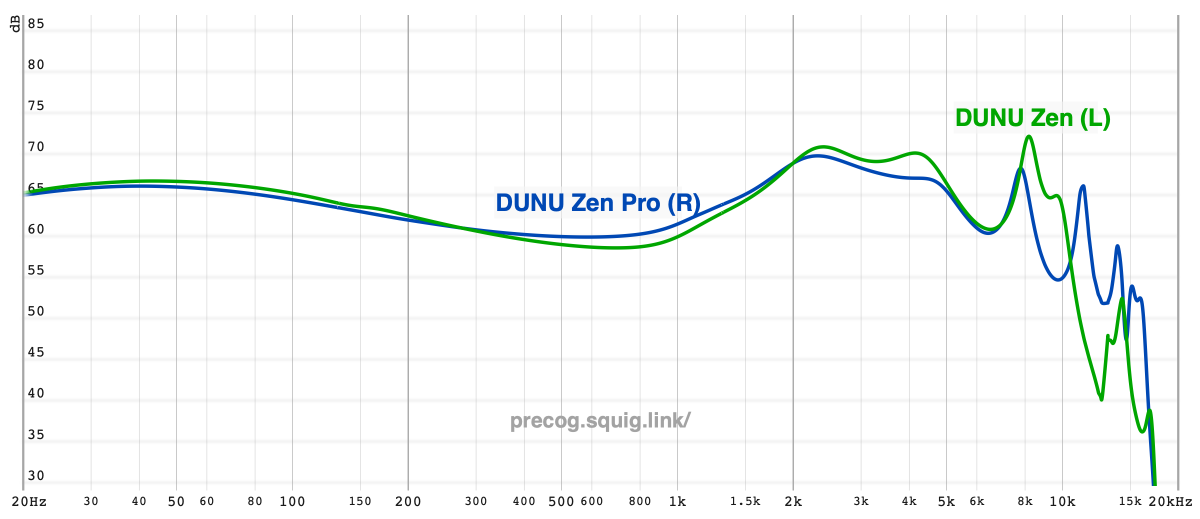DUNU Zen Pro - First Impressions

The DUNU Zen was released roughly six months ago. It was a project that I had excitedly been following for months; the graph looked good, and there was the undeniable allure of a single DD, endgame IEM. Alas, when I got around to hearing my review unit, I was...disappointed. The Zen sounded dark, congested, and generally harsh. I hesitated to drop my review, even prolonging it for months before eventually releasing it.
It’s worth noting that there were people who loved the Zen. But DUNU, highly receptive of feedback as they are, have since opted to release a direct replacement to the Zen called the Zen Pro. It will be released in due time with the IEM hitting international markets first. For now, myself and a number of other reviewers - Super*Review, Resolve, and Antdroid - were asked if we’d like to participate in testing of the IEM with an experimental twist. We would do blind listening without knowledge of the graph or running sine sweeps, write down our thoughts, check the graphs, and then re-evaluate. The Zen Pro was an ideal candidate for this because it was a brand-new IEM that no one had seen before; therefore, there were no existing impressions to confound our own. It was definitely an exciting prospect, as the opportunities for this stuff are limited.
Below you can see the new Zen Pro. Physically, nothing has really changed from the original Zen other than the new titanium finish which looks even better than the original in my opinion.

Notes (without knowledge of the graph, and with a couple hours of listening)
Generally, the overall tonal balance of the Zen Pro hits closer to neutral, whereas the Zen follows more of a dark V-shape (that, honestly, I find somewhat all over the place).
- Bass notes are slightly cleaner on the Zen Pro due to less mid-bass. Clearly not as warm as the Zen on Dreamcatcher’s “Can’t Get You Out of My Mind”.
- Pinna compensation has been dialed back slightly for a cleaner midrange. The perception of a cleaner midrange might also be because some of the bulk in the lower-midrange seems to have been cut. Zen has more texture and body with male vocals on Joe Nichols’ “Sunny and 75”. The Zen Pro’s transition between upper-midrange and lower treble, so say 3-5kHz, appears to follow more of a gentle slope than the Zen did. The opening of Loona’s “Eclipse” has less of a jut to the “s” consonances on the word “sparks”. It’s still not as smooth in this transition as, say, the Moondrop Variations though, as a slightly “glassy” quality pervades which probably isn’t aided by the quicker decay.
- The Zen Pro is not as dark after 10kHz, but is still not particularly airy. Cymbals on Sawano’s “Cage” still lack extension, and the shakers are missing shimmer. The main difference would be that the 9kHz peak on the Zen has been attenuated for a smoother treble response. Percussive hits in the front-left channel of “Into the New World” sound more tonally correct (as does everything else about the treble in general).
The Zen Pro sounds less downwards-compressed than the Zen; however, most of the Zen’s issues in that regard stemmed from the treble response. I wouldn’t say the Zen Pro’s staging sounds like a particular improvement. It’s more so the layering department - distinction between individual instrument lines, vocals, and positioning - that has seen a considerable jump thanks to the tuning. I would say that timbre still has that slightly weird metallic tinge to it at times, perhaps due to a quicker decay like what the JVC FDX1 exhibits. The Zen Pro is still not as timbrally pleasing as the Moondrop KXXS, even if it does have better resolution.
Here is the Zen Pro graphed next to the original Zen:

Post-Knowledge of the Graph Thoughts:
Overall, I’d say my thoughts line up with the graph pretty darn closely. I nailed the pinna compensation and the 3-5kHz region, and mostly got the lower-midrange and bass regions correct relative to how the measurements depict the differences.
The treble, however, isn’t as smooth as I initially thought. Running a sine sweep, the peak at 8kHz is still fairly present - just the amplitude has been lowered relative to the Zen. So I was sort of correct about that. But there’s also an additional peak at 11kHz. I’m guessing it’s harder to notice the 11kHz peak on cursory listening because it’s been positioned higher up, near the air frequencies. This also likely contributes to the Zen Pro’s slightly metallic timbre, not unlike the Focal Clear (although not to that same degree). I do find myself noticing this now after having seen the graph.
Further listening does seem to indicate that the Zen Pro’s ability to articulate the “weight” and intensity of dynamic swings is weaker than the original Zen’s. It’s also flatter for range as whole; however, this is a small price to pay for the improved tonal balance in my opinion.
Final Thoughts
I like the Zen Pro. I hear a lot more of the Luna’s excellent technical performance and, even better, the Zen Pro is considerably more balanced in terms of tonality. To my ears, it presents a decided improvement over the Zen. You might be surprised to know that isn’t something I find with many “Pro” and “MK.II” versions of IEMs.
Now, whether it's competitive for the projected asking price (still TBD, I believe) is more difficult to say. Within the context of single-DDs, yes, there’s a strong possibility. I definitely like the Zen Pro more than the Moondrop Illumination, but I also didn't think the Illumination was nearly worth $800. Cayin's new Fantasy was also, well, nothing more than a fantasy for the price it was intended to command. After hearing the Sennheiser IE900, I don’t think the Zen Pro has that same special sauce, but it’s certainly better in terms of raw tuning. I guess time will tell on this front.
-Precogvision
